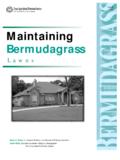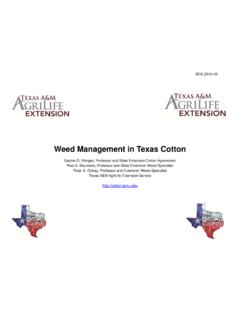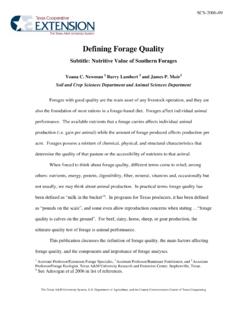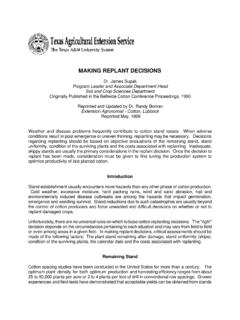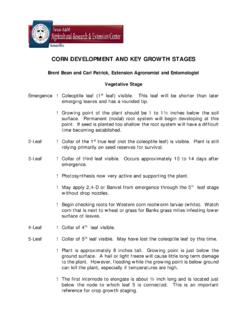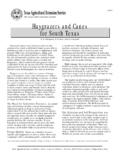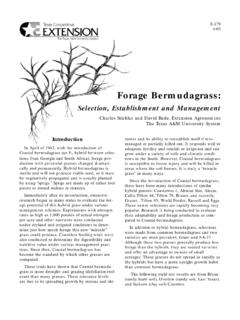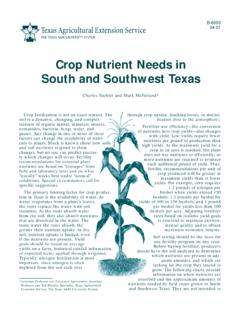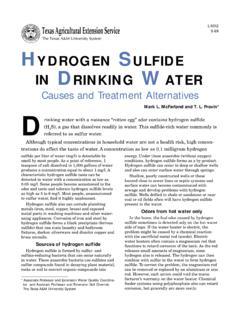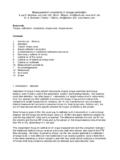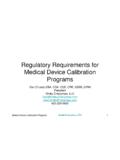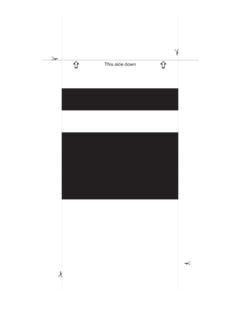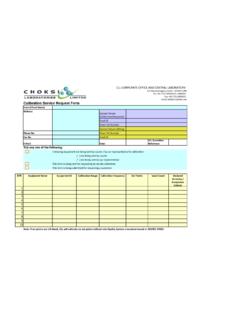Transcription of 10/99 Sprayer Calibration - Texas A&M University
1 Gene R. Taylor, II, Assistant Professor and Extension Turfgrass SpecialistJason Gray, Extension Assistant Urban Water ManagementThe Texas A&M University SystemSprayerCalibrationfor TurfgrassL-533110/99 Before every use, check the Sprayer system and sprayers every fourth application. Before anyspraying operation, make a visual check of the spraying sure all equipment is in working order and that thereare no leaks in hoses or connections. VISUAL inspection check the Sprayer tank approximately half full with water only. (Never add pesticides to a Sprayer until it is checked for leaks and is in good operating condition.)
2 Tank, hoses and fittings for the Sprayer and engage the pump. Water should recirculate into the the pump, hoses and fittings for leaks again and fix any leaks. A small leak at the beginning of the spraying operation may result in a large leak while on the spray boom and check for leaks in the hoses that lead to the boom, the nozzle hoses and the nozzle check the spray pattern from each nozzle. If a nozzle has an improper spray pattern, replace it with a new one of the same style and output the distance between nozzles. Adjust the spray tips to the recommended height from the and and clean the main in-line filter.
3 , clean and replace, if needed, the screen behind each the nozzles removed, engage the pump and flush out any particles or debris. off the pump and return the nozzles to their assemblies, making sure the spray pattern stays in line with the the Sprayer pressure to the appropriate operating pressure for the particular type of nozzles. For example, the optimal operating pressure for flat fan tips is 40 psi (pounds per square inch). a large measuring container (used for Calibration only) catch the output from each of the nozzles for 1 minute and compare to the specified output for the one nozzle s output is off by more than 10 percent, replace it with a new one.
4 If two or more nozzles are off by 10 percent, replace all of the nozzles on the boom. (See section on nozzle Calibration to determine percent error.) the tank half the machine/tractor gear and RPM (revolutions per minute) that will be used during the spraying operation. The gear and RPM settings should allow a speed between 3 to 5 MPH (miles per hour). Actual speed should be based on the conditions of the site to be sprayed and operator ability. (Recalculate Sprayer output anytime the speed of the Sprayer is changed.) When the Sprayer has been thoroughly checked, begin theactual Calibration process.
5 There are three main formulasthat calculate GPA (gallons per acre), GPM (gallons perminute), and MPH (miles per hour). Use each of theseformulas to determine and or change the output of thesprayer over a given area (usually per acre or per 1,000square feet).Proper application of pesticidesand fertilizerson turfgrass is possible only with an accurately calibratedsprayer. Failure to calibrate spray equipment can result in amisapplication of pesticides and fertilizers by more than 10percent. Misapplication can lead to repeat applications,damaged plants, excess cost or environmental contamination.
6 Check and clean filters on the Sprayer before the nozzle height from the ground and the distancebetween nozzles in hour formulaBefore making any of the other calibrationcalculations, determine the actual ground speedof the Sprayer in miles per hour (MPH). out 200 feet of terrain in the area to be sprayed and mark it spray tank to half the booms of the and record an appropriate RPM and gear that allows the tractor to maintain a constant speed while maintaining recommended spray the Sprayer through the 200-foot course at least three times, recording the time, in seconds, for each test run.
7 (Begin the course run well behind the first mark so the Sprayer will be up to full speed when the first mark is crossed. Starting at the line increases the time it takes to cross the 200 feet, thus giving an inaccurate speed estimation.) the three test run times (in seconds). the appropriate course distance and average time (in seconds) into the following formula to calculate the speed of the Sprayer at the selected gear and RPM acre formulaNext, determine the output of the incorporate the output of a single nozzlein gallons per minute (GPM) and multiply by5,940.
8 Then divide by the product of miles perhour (MPH) times the distance between nozzlesin inches (width) on the spray :distance between nozzles in inches, not the width of the boomGPM:the average output of each nozzle in tenths of a gallon, not ounces Example:Assume the following information has been = (output of a single nozzle is 1/2gallon per minute)MPH = (as calculated from the MPH formula)width =18 inches (distance between two nozzles on the boom of the Sprayer )Plug in the correct numbers to the GPA formulaas these set parameters, the Sprayer has anoutput of gallons per acre.
9 To determinegallons per 1,000 square feet, divide the GPAby minute formulaNow that Sprayer output over 1 acre has beendetermined, recalculate the formula to adjustthe output of the Sprayer . In the previous example, the pesticide mustbe applied in 20 gallons of water per acre, GPA from the above calculation is toomuch. Options are to increase the speed of thesprayer or change the output of the nozzles. Do not increase the speed of the Sprayer if itis already at or near 5 MPH. In this example, thespeed is close to 5 MPH, so increasing speed isnot a good option.
10 However, the output of thenozzles can be changed easily by switchingnozzles. To determine the output of the nozzleneeded, use the gallons per minute the same information from the GPAexample, except substitute 20 GPA for GPA calculated for the the 200-foot distance with the tank half full, and at desiredRPM and gear 1 + time 2 + time 33average time ofsprayer to cross 200 = test run distance (ft.) x 60average time x 885,940 x GPMMPH x widthgallons per acre= 5,940 x x 18 GPA= = 2,97081= gallons per 1,000 sq. x MPH x width5,940 GPM = 20 GPA x MPH x 18 inches5,940= GPMP roduced by Agricultural Communications, The Texas A&M University SystemExtension publications can be found on the Web at.
